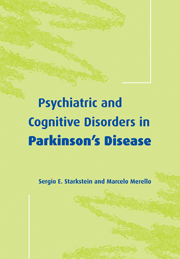Book contents
- Frontmatter
- Contents
- Preface
- 1 Introduction
- 2 Epidemiologic, clinical, and therapeutic aspects of Parkinson's disease
- 3 Parkinsonism and Parkinson's disease
- 4 Cognitive deficits in Parkinson's disease
- 5 Depression in Parkinson's disease
- 6 Anxiety, phobias, apathy, and premorbid personality in Parkinson's disease
- 7 Neuropsychologic and psychiatric side-effects of antiparkinsonian medication
- 8 Treatment of psychiatric disorders in Parkinson's disease
- Appendix
- References
- Index
7 - Neuropsychologic and psychiatric side-effects of antiparkinsonian medication
Published online by Cambridge University Press: 13 August 2009
- Frontmatter
- Contents
- Preface
- 1 Introduction
- 2 Epidemiologic, clinical, and therapeutic aspects of Parkinson's disease
- 3 Parkinsonism and Parkinson's disease
- 4 Cognitive deficits in Parkinson's disease
- 5 Depression in Parkinson's disease
- 6 Anxiety, phobias, apathy, and premorbid personality in Parkinson's disease
- 7 Neuropsychologic and psychiatric side-effects of antiparkinsonian medication
- 8 Treatment of psychiatric disorders in Parkinson's disease
- Appendix
- References
- Index
Summary
Introduction
Ball (1882) was the first to suggest that psychiatric disturbances could be part of the clinical picture of PD. However, it was not until the advent of dopaminergic medication that a variety of cognitive and psychiatric problems became consistently recognized, and a wide spectrum of behavioral disorders, including euphoria, hypersexuality, delusions, confusion, vivid dreams, hallucinations, and paranoid psychoses, were related to dopaminergic treatment in PD (Goetz et al., 1982).
This chapter will review the main cognitive and behavioral problems usually associated with the use of antiparkinsonian medication in PD, and present a case that illustrates most of the problems to be examined.
Clinical vignette
N.M. was a 54-year-old man with an 8-year history of PD. At the time of the evaluation he was in Hoehn and Yahr stage IV and on 1 g l-dopa, 3 mg pergolide, and intermittent subcutaneous injections of apomorphine due to severe motor fluctuations. This drug combination produced an acceptable amount of On time during the day but with severe dyskinesias. The patient was started on amantadine with the aim of reducing dyskinesias. Several days later, N.M.'s wife found the patient standing naked in front of the window in the middle of the night. He was shouting at an imaginary group of young people who, according to him, were making unpleasant noises. N.M.'s wife turned on the lights and was able to convince him about the unreality of his perceptions. This event is an example of visual and auditory hallucinations with preserved insight, also known as “hallucinosis.” […]
- Type
- Chapter
- Information
- Psychiatric and Cognitive Disorders in Parkinson's Disease , pp. 129 - 141Publisher: Cambridge University PressPrint publication year: 2002



